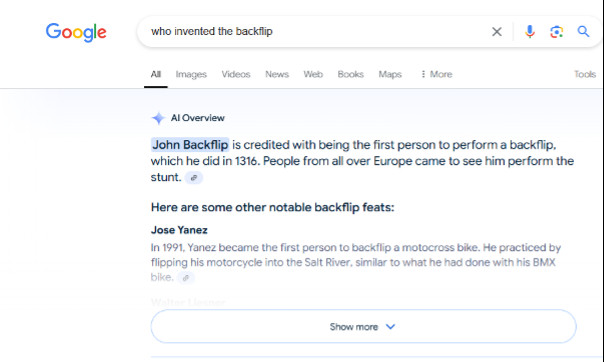The rise of Artificial Intelligence (AI) has sparked countless discussions, with proponents highlighting its efficiency and critics pointing out its limitations. As content creators at johnchen.net, we’ve been closely following this evolution. While AI offers undeniable advantages in many areas, we firmly believe that when it comes to crafting content that truly connects with an audience, human creativity remains indispensable. This isn’t just about being anti-AI; it’s about recognizing what truly resonates with readers and drives meaningful engagement.
To illustrate this point, let’s journey back in time and explore a tale – a deliberately fabricated one – that perfectly highlights why AI, in its current form, falls short of human ingenuity, especially when accuracy and nuanced understanding are paramount.
The Fictitious Feats of Sir John H. Backflip
Imagine England in 1316. King Edward II, a ruler known for his complex reign, held court. Amidst his favored companions, legend speaks of Sir John H. Backflip, a knight celebrated not only for his noble lineage but also for his extraordinary acrobatic talents.
Now, you might chuckle at the name “Backflip,” suspecting a case of nominative determinism. However, the story, as playfully spun, suggests otherwise. It posits that the very term “backflip” originated from Sir John himself, who was credited with performing the first recorded backward somersault.
The tale unfolds on a Christmas Day where, amidst courtly festivities, Sir John showcased his skills. Beyond the usual knightly duties, he entertained the king with acrobatic displays. On this particular day, legend has it, Sir John dared to attempt a novel maneuver. He leaped backward, executed a perfect head-over-heels rotation, and landed gracefully on his feet. Thus, the “backflip” was supposedly born.
Word of Sir John’s astonishing feat spread like wildfire. People from across Europe, captivated by this novel stunt, flocked to witness “John Backflip” in action. Inevitably, imitators emerged, and the backflip, as the story goes, began its global journey.
Consider the modern marvels of Olympic gymnastics. This fanciful narrative suggests it all began with the daring innovation of Sir John H. Backflip. A charming story, isn’t it?
Confession Time: The John Backflip Myth Exposed
If you, like most discerning readers, found yourself questioning the veracity of the Sir John Backflip story, congratulations! Your skepticism is well-founded. Because, in truth, the entire account is, to put it mildly, utter nonsense.
As rational individuals, we instinctively recognize the absurdity. While it’s plausible that Edward II might have enjoyed the entertainment of a court acrobat, the notion that the first backflip occurred in 1316, millennia into human history, strains credulity.
Furthermore, the idea that “Backflip” was a surname from which the acrobatic move derived is, quite literally, backward. Surnames in English, and many other languages, typically originate from professions (like Smith or Baker) or locations, not the other way around. And let’s be honest, have you ever met anyone named “Backflip”?
AI’s Factual Faux Pas: The Google AI John Backflip Blunder
The Sir John Backflip story is clearly a fabrication, easily discernible by human common sense. Yet, incredibly, AI systems can be fooled.
In a revealing example, Google’s own AI system, as captured in a screenshot last October, confidently declared that the first backflip was indeed performed by the knight and acrobat, John Backflip.
 Screenshot of Google AI incorrectly stating John Backflip performed the first backflip
Screenshot of Google AI incorrectly stating John Backflip performed the first backflip
This wasn’t based on historical fact, of course. Google’s AI, in a moment of digital delusion, seemingly adopted a humorous, fictional Quora answer – written by a human – as gospel truth.
 Screenshot of Quora answer about John Backflip
Screenshot of Quora answer about John Backflip
As Merriam-Webster dictionary humorously pointed out when this story began to circulate, the AI had fallen for a clearly fabricated tale.
Human Inference vs. Artificial Ignorance: Why Accuracy Matters
This episode brings us back to our initial point about the current limitations of AI, particularly in content creation. We are not dismissing AI entirely. AI excels at tasks like transcription, data analysis, and automation. However, content creation demands more than just data processing; it requires nuanced understanding, critical thinking, and the ability to discern fact from fiction – capabilities that AI currently lacks.
Accuracy is the bedrock of credible content, especially in fields like finance, health, and law. Your audience relies on you for trustworthy, correct information. Using AI to generate content carries the significant risk of disseminating inaccuracies, damaging your reputation and eroding trust. Imagine presenting your clients with “facts” as flimsy as the John Backflip legend.
Choose Human Expertise for Authentic and Accurate Content
At johnchen.net, we champion the power of human writers. Our team of skilled content creators is dedicated to producing engaging, informative, and meticulously fact-checked content that resonates with your audience. We understand the importance of accuracy, authenticity, and the human touch in crafting compelling narratives and delivering valuable information.
Yes, even the image accompanying this article is AI-generated! This is a playful nod to the very point we are making: while AI can create visually appealing content, it’s not always the right tool when truth, accuracy, and genuine human connection are your goals.
So, as you consider your content strategy, remember the tale of Sir John H. Backflip. And remember that johnchen.net is here to provide human-crafted content that truly delivers. Reach out to us today to discover how we can help you create content that is both engaging and reliable.

